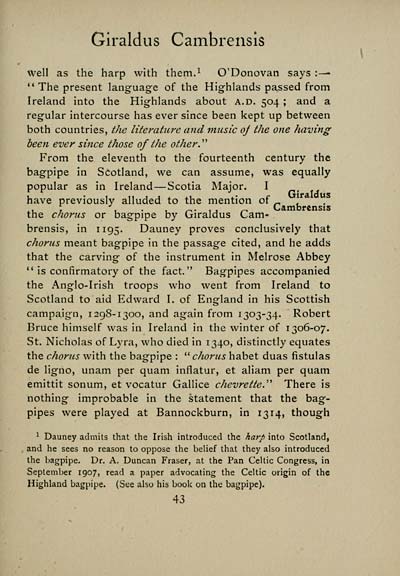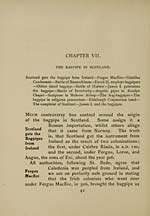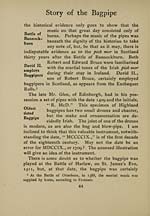Inglis Collection of printed music > Printed text > Story of the bagpipe
(69) Page 43
Download files
Complete book:
Individual page:
Thumbnail gallery: Grid view | List view

Giraldus Cambrensis
well as the harp with them. 1 O'Donovan says :—
" The present language of the Highlands passed from
Ireland into the Highlands about a.d. 504 ; and a
regular intercourse has ever since been kept up between
both countries, the literature and music of the one having
been ever since those of the other."
From the eleventh to the fourteenth century the
bagpipe in Scotland, we can assume, was equally
popular as in Ireland — Scotia Major. I
have previously alluded to the mention of _,
I * . . , Cambrensis
the chorus or bagpipe by Giraldus Cam-
brensis, in 1195. Dauney proves conclusively that
chorus meant bagpipe in the passage cited, and he adds
that the carving of the instrument in Melrose Abbey
" is confirmatory of the fact." Bagpipes accompanied
the Anglo-Irish troops who went from Ireland to
Scotland to aid Edward I. of England in his Scottish
campaign, 1298-1300, and again from 1303-34. Robert
Bruce himself was in Ireland in the winter of 1306-07.
St. Nicholas of Lyra, who died in 1340, distinctly equates
the chorus with the bagpipe : " chorus habet duas fistulas
de ligno, unam per quam inflatur, et aliam per quam
emittit sonum, et vocatur Gallice chevrette.'" There is
nothing improbable in the statement that the bag-
pipes were played at Bannockburn, in 1314, though
1 Dauney admits that the Irish introduced the harp into Scotland,
and he sees no reason to oppose the belief that they also introduced
the bagpipe. Dr. A. Duncan Fraser, at the Pan Celtic Congress, in
September 1907, read a paper advocating the Celtic origin of the
Highland bagpipe. (See also his book on the bagpipe).
43
well as the harp with them. 1 O'Donovan says :—
" The present language of the Highlands passed from
Ireland into the Highlands about a.d. 504 ; and a
regular intercourse has ever since been kept up between
both countries, the literature and music of the one having
been ever since those of the other."
From the eleventh to the fourteenth century the
bagpipe in Scotland, we can assume, was equally
popular as in Ireland — Scotia Major. I
have previously alluded to the mention of _,
I * . . , Cambrensis
the chorus or bagpipe by Giraldus Cam-
brensis, in 1195. Dauney proves conclusively that
chorus meant bagpipe in the passage cited, and he adds
that the carving of the instrument in Melrose Abbey
" is confirmatory of the fact." Bagpipes accompanied
the Anglo-Irish troops who went from Ireland to
Scotland to aid Edward I. of England in his Scottish
campaign, 1298-1300, and again from 1303-34. Robert
Bruce himself was in Ireland in the winter of 1306-07.
St. Nicholas of Lyra, who died in 1340, distinctly equates
the chorus with the bagpipe : " chorus habet duas fistulas
de ligno, unam per quam inflatur, et aliam per quam
emittit sonum, et vocatur Gallice chevrette.'" There is
nothing improbable in the statement that the bag-
pipes were played at Bannockburn, in 1314, though
1 Dauney admits that the Irish introduced the harp into Scotland,
and he sees no reason to oppose the belief that they also introduced
the bagpipe. Dr. A. Duncan Fraser, at the Pan Celtic Congress, in
September 1907, read a paper advocating the Celtic origin of the
Highland bagpipe. (See also his book on the bagpipe).
43
Set display mode to: Large image | Transcription
Images and transcriptions on this page, including medium image downloads, may be used under the Creative Commons Attribution 4.0 International Licence unless otherwise stated. ![]()
| Special collections of printed music > Inglis Collection of printed music > Printed text > Story of the bagpipe > (69) Page 43 |
|---|
| Permanent URL | https://digital.nls.uk/94510004 |
|---|
| Description | Scottish and English songs, military music and keyboard music of the 18th and 19th centuries. These items are from the collection of Alexander Wood Inglis of Glencorse (1854 to 1929). Also includes a few manuscripts, some treatises and other books on the subject. |
|---|
| Description | The Glen Collection and the Inglis Collection represent mainly 18th and 19th century Scottish music, including Scottish songs. The collections of Berlioz and Verdi collected by bibliographer Cecil Hopkinson contain contemporary and later editions of the works of the two composers Berlioz and Verdi. |
|---|

